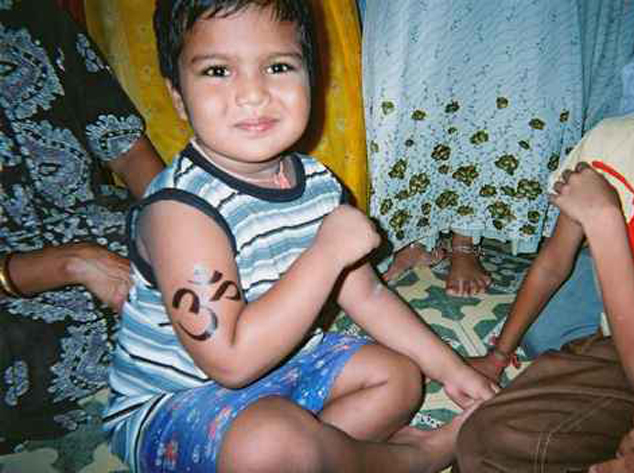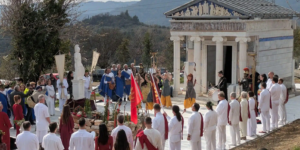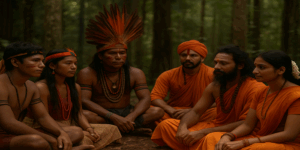 Some Hindus these days think we should stop using the Hindu label as an identity because its origins are foreign. Regretfully even some Hindu gurus and swamis have joined the fray by also expressing their reservations about its feasibility for the Hindu community worldwide. However, on closer reflection any idea of ditching the term ‘Hindu’ is as impractical as it is unrealistic.
Some Hindus these days think we should stop using the Hindu label as an identity because its origins are foreign. Regretfully even some Hindu gurus and swamis have joined the fray by also expressing their reservations about its feasibility for the Hindu community worldwide. However, on closer reflection any idea of ditching the term ‘Hindu’ is as impractical as it is unrealistic.
 Using the term Sanatan or Vedic or Indic or any other label instead will not only obscure and confuse Hindu identity even more but will also lead to greater proliferation of identitarian politics where each sect within the Hindu fold seeks its own separate status falling to divide and rule by political opportunists . There’s already some claiming Vaishnavism or Shaivism , or Vedantism are not Hindu or part of Hinduism.
Using the term Sanatan or Vedic or Indic or any other label instead will not only obscure and confuse Hindu identity even more but will also lead to greater proliferation of identitarian politics where each sect within the Hindu fold seeks its own separate status falling to divide and rule by political opportunists . There’s already some claiming Vaishnavism or Shaivism , or Vedantism are not Hindu or part of Hinduism.
Many Hindu tribals have already been classed as non Hindu, opening the door to conversion.
It also suits the agenda of divorcing Yoga , Tantra and other Hindu practices from the ‘Hinduism’ label because if Hinduism or Hindu don’t exist then these practices have no intellectual property protection or ownership but are there to steal and exploit.
While it is true that the term “Hindu” may have been foreign in origin (or to some theories it could very well originate from India itself ) and at a time it may have been used as a derogatory label by foreigners it is nevertheless simply baseless to claim that the Hindu people feel this way about the word “Hindu” when looking back at history
In actual fact, the Vijaynagar Empire was proud to call itself “Hindu” in its long struggle to maintain and preserve our culture. Shivaji and his Maratha followers were also proud to call themselves “Hindus”. Indeed, countless children of Hinduism were proud to fight and protect their culture in the true heroic and Dharmic traditions taught by Krishna in the Gita.
For your benefit, we quote some epigraphic evidence and its implication as cited from “Hindus and Hinduism: Manipulation of Meanings” by Sita Ram Goel:
 ‘The Somalpuram Grant of the Vijayanagara king Virupaksa is dated Saka samvat 1389 (AD 1467). It describes the king (“in the glowing fire of whose valour, the Turushkas were scorched up”) as “elevated by the titles such as hinduraya-suratrana”. In the Hempe inscription of Krishnadevaraya, dated Saka samvat 1430 (AD 1508), the hinduraya-suratrana is described as the “destroyer of rogue tigers.” The hint is more than clear: rogue tigers are the Muslim invaders.
‘The Somalpuram Grant of the Vijayanagara king Virupaksa is dated Saka samvat 1389 (AD 1467). It describes the king (“in the glowing fire of whose valour, the Turushkas were scorched up”) as “elevated by the titles such as hinduraya-suratrana”. In the Hempe inscription of Krishnadevaraya, dated Saka samvat 1430 (AD 1508), the hinduraya-suratrana is described as the “destroyer of rogue tigers.” The hint is more than clear: rogue tigers are the Muslim invaders.
The same description of him is found in his Udayambakam Grant dated Saka samvat 1450 (AD 1528), two years before he died.
In an inscription found at the holy city of Gaya in Bihar , the Vijayanagara king Acyutadevaraya is eulogised as “hinduraya-suratrana, the firm establisher of the Hindu kingdom.” His Unamanjeri Plate issued in Saka samvat 1462 (AD 1540) calls him not only hinduraya-suratrana but also induvamsa-sikhamani (the jewel in the crown of the lunar dynasty). The same applause is reserved for Sadasivaraya in his Kanuma Grant dated Saka samvat 1478 (AD 1556).’
 ‘Thus by the middle of the fourteenth century, the word “Hindu” had dropped the derogatory associations imposed on it by the Iranians and the Islamic invaders, and acquired a lot of lustre in the eyes of our countrymen. Native heroes such as Maharana Kumbhakarna and Krishnadevraya, who defeated the Islamic onslaught, were hailed as the Hindu heroes in subsequent centuries.
‘Thus by the middle of the fourteenth century, the word “Hindu” had dropped the derogatory associations imposed on it by the Iranians and the Islamic invaders, and acquired a lot of lustre in the eyes of our countrymen. Native heroes such as Maharana Kumbhakarna and Krishnadevraya, who defeated the Islamic onslaught, were hailed as the Hindu heroes in subsequent centuries.
Padmanabha uses the word “Hindu” for glorification of the Chauhana heroes of Jalor in his epic poem, Kanhadade-prabandha, which he composed in AD 1455. It will not be long before Maharana Pratapa Simha of Mewar becomes renowned as hindu-kula-kamala-divakara, that is, the Sun which brings bloom to the lotus that is the Hindu nation.
 Chhatrapati Shivaji, who turned back the tide of Islamic invasion and inaugurated the war of liberation from Islamic imperialism, will be hailed all over Bharatavarsa as the saviour of Hindu Dharma and the protector of its significant symbols – gau-brahmana, sikha-sutra, devamurti-devalaya, , the same with Maharaja Chhatrasal.’
Chhatrapati Shivaji, who turned back the tide of Islamic invasion and inaugurated the war of liberation from Islamic imperialism, will be hailed all over Bharatavarsa as the saviour of Hindu Dharma and the protector of its significant symbols – gau-brahmana, sikha-sutra, devamurti-devalaya, , the same with Maharaja Chhatrasal.’
‘And the word “Hindu” stood sanctified when Sanatana Dharma became known as Hindu Dharma. Numerous saint-poets arose in all parts of Bharatavarsa who sang hymns in praise of Hindu Dharma, and who reminded their countrymen that they were inheritors of a great and vast spiritual vision.’
 Hindu may have had foreign origins as an ethno-geographic term. Yet in its present context and usage it refers not just to people from India who follow an ancient tradition which alone has survived while others have become extinct as the dodo, but it also stretches all the way across south east Asia, and even further into the West with millions of followers with Western born gurus like Satguru Subramanian Swamy( Hinduism today) or Vedic Scholars like Vamadev Shastri and many more..
Hindu may have had foreign origins as an ethno-geographic term. Yet in its present context and usage it refers not just to people from India who follow an ancient tradition which alone has survived while others have become extinct as the dodo, but it also stretches all the way across south east Asia, and even further into the West with millions of followers with Western born gurus like Satguru Subramanian Swamy( Hinduism today) or Vedic Scholars like Vamadev Shastri and many more..
The label Hindu has evolved like Hinduism/Sanatan Dharma and its diverse Dharmic paths and should be welcomed as the unifying Identity for its global followers regardless if they are Indian or not.


































In an ideal Hindu rashtra there would be plenty of opportunities to explore the intricacies of Vedic Sanatani Aryan roots and identities for Hindus coming down from eternity. But, for all practical purposes now in today’s world Hindus need to have one identity to unify under.
For the purpose of existing one can take on any label one is given for there are hardly any choices.. but in order to take a stand one needs to define himself.
Hindus today stand at that defining moment in history where either they get reduced to a mere existence (such as Native Americans) and perish
OR
come out, so to speak, and make a stand as a unique culture and race of people on world stage and claim their rightly deserved position as one of world’s most practiced religion and especially as a creed having solutions for humanity’s ills.